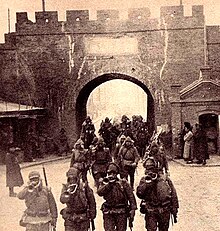
Back الغزو الياباني لمنشوريا Arabic Invasión xaponesa de Manchuria AST ژاپونین منچوریی ایستیلاسی AZB Японская інтэрвенцыя ў Маньчжурыю (1931) Byelorussian Японска интервенция в Манджурия Bulgarian Invasió japonesa de Manxúria Catalan Japonská invaze do Mandžuska Czech Mandschurei-Krise German Ιαπωνική εισβολή στη Μαντσουρία Greek Invasión japonesa de Manchuria Spanish
This article needs additional citations for verification. (December 2022) |
| Japanese invasion of Manchuria | |||||||||
|---|---|---|---|---|---|---|---|---|---|
| Part of the interwar period | |||||||||
 Japanese troops marching into Shenyang on September 18, 1931 | |||||||||
| |||||||||
| Belligerents | |||||||||
|
| ||||||||
| Commanders and leaders | |||||||||
|
|
| ||||||||
| Strength | |||||||||
| 30,000–60,450 men[citation needed] | 160,000 men | ||||||||
| Japanese invasion of Manchuria | |||||
|---|---|---|---|---|---|
| Chinese name | |||||
| Traditional Chinese | 九一八事變 | ||||
| Simplified Chinese | 九一八事变 | ||||
| |||||
| Alternative name | |||||
| Traditional Chinese | 瀋陽事變 | ||||
| Simplified Chinese | 沈阳事变 | ||||
| |||||
| Japanese name | |||||
| Kanji | 滿洲事變 | ||||
| Kana | まんしゅうじへん | ||||
| |||||
The Empire of Japan's Kwantung Army invaded the Manchuria region of the Republic of China on 18 September 1931, immediately following the Mukden Incident.[2] At the war's end in February 1932, the Japanese established the puppet state of Manchukuo. Their occupation lasted until the success of the Soviet Union and Mongolia with the Manchurian Strategic Offensive Operation in mid-August 1945, towards the end of the Second World War.
The South Manchuria Railway Zone and the Korean Peninsula had been under the control of the Japanese Empire since the Russo-Japanese War of 1904–1905. Japan's ongoing industrialization and militarization ensured their growing dependence on oil and metal imports from the US.[3] The US sanctions which prevented trade with the United States (which had occupied the Philippines around the same time) resulted in Japan furthering its expansion in the territory of China and Southeast Asia.[4] The invasion of Manchuria, or the Marco Polo Bridge Incident of 7 July 1937, are sometimes cited as alternative starting dates for World War II, in contrast with the more commonly accepted date of September 1, 1939.[5]
With the invasion having attracted great international attention, the League of Nations produced the Lytton Commission (headed by British politician Victor Bulwer-Lytton) to evaluate the situation, with the organization delivering its findings in October 1932. Its findings and recommendations that the Japanese puppet state of Manchukuo not be recognized and the return of Manchuria to Chinese sovereignty prompted the Japanese government to withdraw from the League entirely.
- ^ "Tōjō Hideki - prime minister of Japan". britannica.com. Retrieved 27 March 2018.
- ^ "Milestones: 1921–1936 - Office of the Historian". history.state.gov. Retrieved 2023-03-02.
- ^ Walker, Michael (2017). The 1929 Sino-Soviet War: The War Nobody Knew. Modern War Studies. ISBN 978-0700623754.
- ^ Meyer, Michael (9 February 2016). In Manchuria: A Village Called Wasteland and the Transformation of Rural China. Bloomsbury USA. ISBN 978-1620402887.
- ^ Simkin, John (February 5, 2007). "Sterling and Peggy Seagrave: Gold Warriors". The Education Forum. Archived from the original on June 13, 2008. Retrieved June 13, 2008.
Americans think of WW2 in Asia as having begun with Pearl Harbor, the British with the fall of Singapore, and so forth. The Chinese would correct this by identifying the Marco Polo Bridge incident as the start, or the Japanese seizure of Manchuria earlier.
© MMXXIII Rich X Search. We shall prevail. All rights reserved. Rich X Search